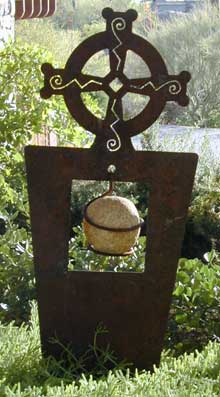
 Our ancestors lived consciously with nature, recognizing the interplay of things seen and unseen. They used various techniques, including sound, dance and darkness, to access the hidden realms, in search of wisdom, guidance, healing. Today, these mystical techniques have become recognized once again under the practice of shamanism.
Our ancestors lived consciously with nature, recognizing the interplay of things seen and unseen. They used various techniques, including sound, dance and darkness, to access the hidden realms, in search of wisdom, guidance, healing. Today, these mystical techniques have become recognized once again under the practice of shamanism.
Shamanism is a mystical, earth-centered practice rooted in an animistic world-view. A shaman, or shamanic practitioner, is someone who consciously and willingly enters an altered state to access other realms of existence for a specific purpose. She/he can be said to `walk between the worlds' to restore harmony and facilitate healing. The shaman's path is one of direct, personal experience of the Great Divine, the Otherworld, Spirit. It is a path that brings knowledge and the potential for personal transformation through co-creative action with the Sacred.
While the word shaman comes from the Tungus culture of Siberia, every culture had, and has, its own mystical practices, and commonalities of both techniques and beliefs exist across cultures. For example, shamanic practitioners believe in the existence of alternate realities, as well as beings that inhabit those realms. They believe in a divine force that ensouls everything, thereby giving life and consciousness to everything that exists. Shamanic practitioners view all things as being interconnected, a part of a universal network or web.
Techniques for accessing the Otherworld vary from culture to culture. However, each tradition uses some form of the shamanic journey, in which the shamanic practitioner willingly shifts her/his consciousness and voyages into the Otherworld. This technique forms the cornerstone of any shamanic practice. Once a practitioner begins using shamanic journey techniques to interact with the Otherworld, her/his personal, mystical cosmology activates to shape the co-creative process that unfolds, making shamanism a deeply personal practice.
Celtic shamanism is one form of shamanism that continues to call people to circles. As diverse as the Celtic peoples, Celtic shamanism remains firmly rooted in the mystical traditions of its forebears. With their profound reverence for the earth, practitioners of Celtic shamanism call to and work closely with the elements, seeking a path of harmony with nature. Celtic shamans view this reality as interwoven with the Otherworld without separation; therefore, they work with the thin places, recognizing that what happens in one realm affects the other in the never-ending spiral of life. Celtic shamanism ultimately encourages practitioners to walk between the worlds to align themselves with and thereby manifest the harmony of the Sacred Three in the natural, co-creative process of living. As a practitioner of Celtic shamanism, this philosophy flows behind and through my practice and teaching.
|